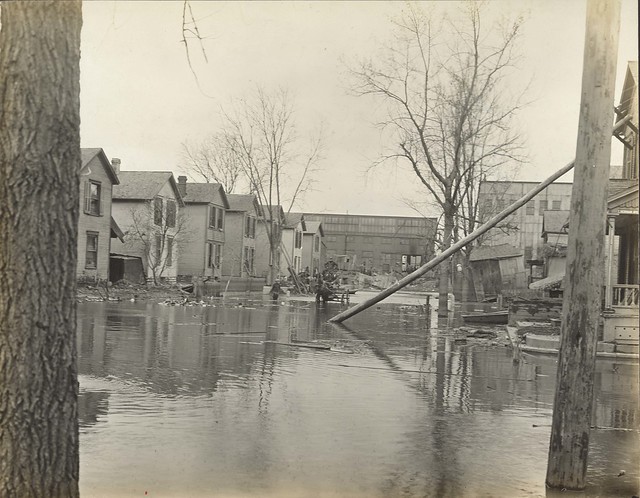
In 1913, a devastating flood buried the city of Dayton, Ohio. In some parts of the city, more than 20 feet of water from the Great Miami River covered houses, businesses, factories, and other buildings, resulting in a tremendous loss of property and life.
The Brethren in Christ Mission in Dayton — a fledgling endeavor launched only less than a year before by pioneering urban missionaries William and Susie Boyer — was caught in the midst of this disaster. Today’s Photo Friday shares the stories of mission workers who witnessed the flood firsthand.
After the jump: Mission workers describe their harrowing experiences during the 1913 Dayton flood.
In his book Mission on Taylor Street: The Founding and Early Years of the Dayton Brethren in Christ Mission, noted American historian Paul Boyer — grandson of the mission’s founders — devotes an entire chapter to the mission personnel’s experiences during the flood. He describes how his father Clarence Boyer (then only a child) and mission worker Emma Cassel helped a houseful of people — including Boyer’s sister and aged grandfather, along with other mission personnel — escape the confines of the rapidly submerging mission house:
Using a side railing from a wooden bedstead as a battering ram, [Emma] and Clarence together punched a hole through the second-floor ceiling into the attic. [By this time, the basement and first floor of the mission house were already underwater.] By piling mattresses on a bed and putting a chair on top, they created a precarious means of escape from the still-rising water. Taking the bed rail to the attic, young Clarence managed to punch a hole through the roof itself. When the water neared the second floor, the group made its way up the crude “ladder” to the relative safety of the attic . . . taking with them some bedding, clothing, and provisions — including, somewhat incongruously, a pan of home-made candy.
In an account published a few weeks later in the Evangelical Visitor, Emma Cassel described the group’s experience on the mission roof:
It was very quiet; only the rushing of the waters could be heard. [A fellow mission worker] and I talked things over and felt that we had done all we could, and could safely trust God for the rest. A little later, we heard the firing of guns, saw people on the housetops, heard their shrieks and cries, some drowing, buildings tipping over and floating in the streets, etc.
Eventually, all members of the mission party were rescued. When the waters receded, mission workers surveyed the damage; according to Paul Boyer, they found that the “lower part of the house was, of course, a muddy ruin, and most of the foundation on the north side [of the house] had collapsed into the basement. . . . Nevertheless, the building proved salvageable, and indeed the work of restoration went surprisingly quickly, as Brethren in Christ church members from the country pitched in to do the necessary cleaning and repairs.” By 1916, the workers and their volunteer laborers had completed renovations and had even built a chapel addition.
For more on the disaster and its effect on the Brethren in Christ mission in Dayton, see Boyer, Mission on Taylor Street, p. 66-73.

Emma Cassel was my grandmother and I think she was there because she was one of the early women on the BIC Home Mission Board. I don’t know how long they were there, but it was a visit. My mother, Miriam, who was a young child was there with her. My mother had gotten sick before the flood, and since they were without food f or 4 days, got very sick indeed. The family back home did not know for a week if they were alive. Clarence Boyer was 13 or 14 at the time, so must have been quite a hero. This info. was in one of my aunt’s letters, and my grandmother had also written an article for the Evangelical Visitor about her own experiences there.